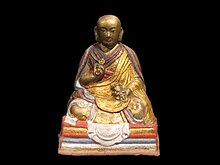Jebtsundamba Khutuktu
Samding Dorje Phagmo The Jebtsundamba Khutuktu[a] or Khalkha Jetsün Dampa Rinpoche is a title given to the spiritual head of the Gelug lineage of Tibetan Buddhism in Mongolia.[2] Like Zanabazar, the 2nd Jebtsundamba Khutughtu was a member of Mongolia's highest nobility and direct descendant of Genghis Khan.After Chingünjav's rebellion and the demise of the second Jebtsundamba Khutugtu, the Qianlong Emperor of the Qing dynasty decreed in 1758 that all future reincarnations were to be found from among the population of Tibet.A reincarnation was in fact found almost at once in north Mongolia, and some high lamas of the dead Khutughtu's suite went to interview the child's mother, Tsendjav, and to instruct her in the details of the life of the former incarnation, so that she could familiarize the child-candidate with the tests which he would have to undergo.Faced with the possibility of a new Khutughtu who was born within Mongolia and was not even a foreigner from Tibet, the Central Committee of the Mongolian People's Revolutionary Party decided in July 1925 to turn the matter over to the elderly 13th Dalai Lama in Lhasa.


Tibetan BuddhismSchoolsNyingmaBodongJonangPadmasambhāvaŚāntarakṣitaKamalaśīlaSongtsen GampoTrisong DetsenRalpacanAtiśaTalikaAbhayakirtiNigumaSukhasiddhiMilarepaYeshe TsogyalLongchenpaJigme LingpaPatrul RinpocheDudjom LingpaMiphamRangjung DorjeDolpopaTaranathaSakya PanditaGorampaSamding Dorje PhagmoJe Tsongkhapa5th Dalai Lama13th Dalai Lama14th Dalai Lama10th Panchen LamaTeachingsThree marks of existenceSkandhaCosmologySaṃsāraRebirthBodhisattvaDharmaDependent originationFour Tenets systemRangtong-ShentongSvatantrika-Prasaṅgika distinctionDzogchenPointing-out instructionLamrimPāramitāsBodhicittaAvalokiteśvaraMeditationVajrayanaTantra techniquesDeity yogaGuru yogaDream yogaThukdamBuddhahoodMajor monasteriesTradrukDrepungGandenJokhangKumbumLabrangMindrollingNamgyalNarthangNechungPabonkaPalchoRalungRamocheTashi LhunpoTsurphuDalai LamaPanchen LamaKarmapaRinpocheTertönWestern tulkuFestivalsChotrul DuchenDajyurGaldan NamchotDosmocheMonlamSho DunLosoongKangyurTengyurTibetan Buddhist canonMahayana sutrasNyingma GyubumSand mandalaThangkaWall paintingsAshtamangalaTree of physiologyFestival thangkaMani stoneHistoryTimelineOutlineCultureIndex of articlesMongoliaZanabazarTüsheet Khan2nd Jebtsundamba KhutughtuGenghis KhanChingünjavQianlong EmperorQing dynastyOuter Mongoliadeclared independenceBogd KhanBogd Khanate of MongoliaMongolian People's Republicseparation of church and state9th Jebtsundamba KhutughtuÖndör Gegeen Zanabazar3rd Jebtsundamba Khutughtu6th Jebtsundamba Khutughtu